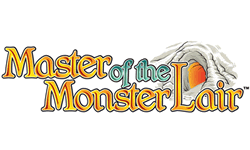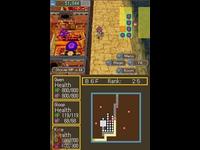|
|

|
PLATFORM
|
DS
|
BATTLE SYSTEM
|

|
INTERACTION
|

|
ORIGINALITY
|

|
STORY
|

|
MUSIC & SOUND
|

|
VISUALS
|

|
CHALLENGE
|
Very Easy
|
COMPLETION TIME
|
40 - 60 Hours
|
|
OVERALL

|
+ Unique gameplay concepts.
- Battle system is slow and very easy.
- Low monster variety.
- Gameplay is too repetitious.
- Lousy dialogue and music.
|
Click here for scoring definitions
|
|
|
Having completed the entirety of the town of South Arc's educational system at the ripe age of twelve, Owen, who apparently has no family or set career path, decides to wander alone in the wilderness while looking for a job. Fortune favors him, as he happens to stumble across a talking, magic shovel that exists solely to dig dungeons. And so, Owen the Dungeon Digger is tasked with physically carving a
multi-level labyrinth out of a nearby mountain's interior, then murdering all the beasts that move into it each night, all while South Arc's adult inhabitants apathetically benefit from his troubles. Master of the Monster Lair is a unique sort of dungeon-making game. It clearly targets a young demographic and has some original ideas. Unfortunately, the bland and repetitive gameplay and mind-numbingly low difficulty take a creative, balanced foundation and construct an empty, one-room playhouse on top of it. A self-amusing child might be happy there, but everyone else will be bored.
The gameplay premise seamlessly weaves together pieces from disparate genres. Every morning, Owen enters his dungeon, clears out the monsters dwelling there at his leisure, and expands the living area in the maze by adding new rooms and passages. Traversing the grid-based lair takes place in real-time. Monsters, represented by purple blobs, visually inhabit the rooms in the maze. Whenever Owen steps in a tile adjacent to one with a monster, it will rush him and initiate a standard, turn-based battle. All adjacent monsters who can see the character will attack in this way, so battles can have from one to three foes since there can be a maximum of three squares next to the player. The gameplay, then, combines aspects of a dungeon-crawler, a god-game, and Dragon Quest.
The combination of the various elements is more integrated than patchwork, and they feed each other in a natural, flowing manner. Because the player designs the dungeon, the number and type of enemies in each encounter is in the gamer's control. It is important to craft the dungeon in such a way that the eventual crawl will be enjoyable, but also functional so that the battles will yield positive results. The trick here is that as the number of enemies in an encounter increases, the probability that an item will drop increases. Furthermore, only the last monster killed can drop an item. If a floor has a tough, armored foe who can drop
high-quality equipment, it behooves the player to layout the rooms such that the armored baddie will be fought at the same time as two lesser, easier enemies. This way the weaker foes can be dispatched first, and when the hardened one is slain last, the chance of an item dropping is the highest possible. Because different rooms attract different monsters, this is easily manageable.
 Three ways to see your location in the dungeon clutter the screen.
Three ways to see your location in the dungeon clutter the screen.
|
|
Two additional party members join Owen early on: a Mimic Slime named Gloop, and a barely older child named Kate. There are no experience points or character levels in Master of the Monster Lair, although growth is still completely influenced by battles. The two humans, Owen and Kate, gain permanent statistical boosts by eating dinner at night. Meals are all made from scrumptious monster body parts. Recipes are gradually learned over the course of the game, and the better ones which give larger boosts require the player to intentionally search out rarer types of beast-meat. Because food is harvested from the fresh corpses of slaughtered enemies (in other words, they are dropped as items), this becomes another necessary consideration in the dungeon's construction. Gloop grows by copying an opponent's head, arms, body, and legs. After battle, the option sometimes appears for Gloop to mimic a foe's body part. By continually mimicing stronger monsters throughout the game, Gloop's stats increase and it can learn new magic spells. Copied body parts also determine what equipment Gloop can use, and often confer special abilities.
All of this is balanced splendidly and should make for an exciting, interesting experience. Sadly, the pacing, ease, and blatant recycling of the gameplay all ruin it with a series of gaffs. The monster variety is severely lacking. For most of the game, each floor only has around five or six monster types in it. For the entire time it takes to pass a floor, the player will be defeating these same enemies countless times. This is made worse by the need to collect items from specific monsters. If a hog drops the item needed to make the best meal possible, then the player will be fighting hogs every single game-day until a new, better recipe appears. There is some palette-swapping of enemies too, but even worse is the reuse of enemies. Monsters from previous floors often reappear on future floors, sporting the same graphic, moves, and item drops. They are scaled, so a crowbat on the first floor is much weaker than a crowbat on the eighth floor, but it does not change the fact that a more fleshed out bestiary is seriously needed.
Compounding this is the Magic Shovel's horribly low initial MP. MP is needed to place a room, remove a room, or carve out a tile. It is the single most limiting factor in progressing through the game, since the shovel only gets a set amount of MP each day. At first, Owen will hardly be able to make space for and place three rooms at a time, and the gameplay quickly becomes methodical. Every day the Magic Shovel outright tells Owen which rooms are required to lure the next boss into the dungeon. Playing involves slowly lair-smithing one tiny piece of the maze at a time, cleaning out the day's residents along the way, picking up new items and equipment from their drops, and taking home their flesh to eat at night, until finally the conditions are met for the boss to show up. If a boss is lured in too early, some level-grinding may be necessary to defeat it, but as long as the party is equipped with the best items and magic available, boss encounters should not be difficult.
 Forward-thinking monster design.
Forward-thinking monster design.
|
|
The interface is simple, but again, some poor decisions make playing the game awkward and slow. In case the excruciatingly easy and monotonous battles are not sleep-inducing enough, many actions slap an enormous text bubble on the screen, putting a temporary halt to the fight and lengthening the already dull encounter. These messages range from the name of a used skill, to status changes, to deaths. Executing a powerful attack against three enemies, then, presents a message when the ability is used, another when the first enemy dies, another when the second enemy dies, and another when the third enemy dies. One move can pause the battle this way four times. Spread this across all of the mindlessly easy battles and it is infuriating. When crafting the labyrinth, the same button executes all of the manipulation commands as well as closing
post-battle messages. Smashing the button a lot to pass through these messages more quickly can cause Owen to delete a room accidentally if it is pressed too many times, thus wasting precious MP.
The story and translation offer nothing of note. In a low attempt to appeal to children, the game's script has a noticeable ban on three syllable words. The language is insultingly simple, and every adult in the game talks down to Owen. Thankfully, there is not much to the script; the plot is threadbare and ignorable. While there is a meager attempt at humor, it feels like a bad, weekday-morning cartoon clearly aimed for children too young to be in school yet. Also ignorable, via the DS's volume slider, is the ear-grating noise passed off as music. The player can choose between several irritating background songs to play while crawling, but RPGamer's Sound Test curator could surely write better game music given half a day. The dungeon graphics are bland and dirt-colored. The monster design tries to channel Dragon Quest, however it comes across like a low quality rip-off.
It is fully possible that Master of the Monster Lair is a child's dream come true: a fascinating dungeon-making RPG for tots. For anyone with gaming experience, though, this
snooze-fest is a slow, boring, repetitive waste of time. The game is surprisingly long -- around sixty hours -- and its potential really shines near the end. In the final floors, the Magic Shovel's MP is high enough for the player to construct large swaths of the dungeon at a time. There is a wide variety of rooms to place, and most can attract more than one type of monster. There is an assortment of enemies. Truly, the game is fun at that point, when all the good aspects are there without any of the limits on diversity and dungeon-altering actions. It is way too late, though, and not worth drudging through fifty hours of tedious mediocrity just to see what the game could have been.
Review Archives
|









